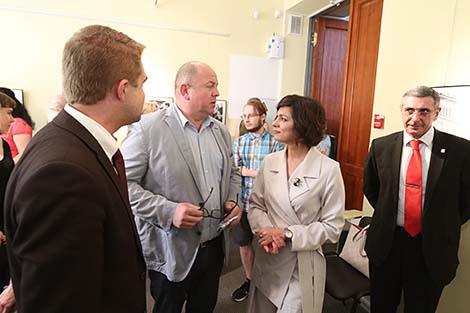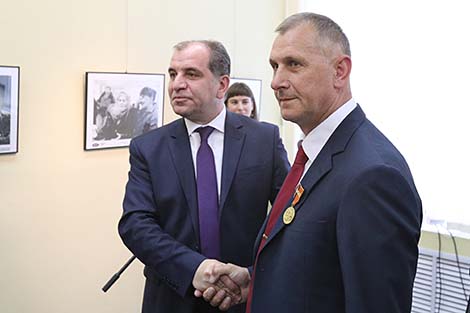Opinions & Interviews
Opinion: Spitak exhibition shows that together we can overcome any tragedy

BelTA Director General Irina Akulovich and BelTA photo correspondent Arkady Nikolayev
MINSK, 24 July (BelTA) – The retrospective photo exhibition about the Spitak earthquake tragedy shows that together we can overcome any tragedy, BelTA Director General Irina Akulovich said at the opening ceremony of the exhibition at the National History Museum in Minsk, BelTA has learned.
“We were dealing with the earthquake aftermath in Armenia together. When we are together, then everything works out. This is what we wanted to show in this exhibition: to recall the tragedy and to remember that we can do little alone and much when we are together,” Irina Akulovich said.

According to her, sometimes it is very difficult for photo correspondents and journalists to work. “When you see grief and death, it breaks your heart. BelTA’s photos presented here are very touching and moving,” she noted.
 ARMENPRESS Director General Aram Ananyan
ARMENPRESS Director General Aram Ananyan


Ambassador Extraordinary and Plenipotentiary of Armenia to Belarus Armen Ghevondyan
Ambassador Extraordinary and Plenipotentiary of Armenia to Belarus Armen Ghevondyan recalled that the northern part of Armenia shuddered from a powerful earthquake on 7 December 1988. “It lasted only 30 seconds but claimed 25,000 lives. 30 years of pain for relatives, friends and colleagues. 30 seconds marked the beginning of the chronicle that has lasted till today in the name of rebuilding and prosperity of destroyed villages and towns. The Spitak tragedy is also a chronicle of humanism and mutual assistance. Following the news of the terrible tragedy thousands of doctors and rescue workers from hundreds of countries from all continents came to Armenia. They brought medicine and equipment. They also strengthened our faith and brought us hope. In the most difficult days Belarus also extended us a helping hand and helped us fight for every life. Today the loud silence of these photos communicates the atmosphere of those days,” the ambassador said. He stressed that the documentary project has been made possible through the partnership of BelTA and ARMENPRESS.
The Spitak Tragedy: A Retrospective of Memory exhibition marks the 30th anniversary of the earthquake. It features 34 works made by photographers of the BelTA and ARMENPRESS news agencies in the tragic days. They show both the disaster and the response of all humanity, and in particular of the Belarusian nation. “With this exhibition we also speak about the future we are shaping today,” ARMENPRESS Director General Aram Ananyan said. "We want to bring this exposition to Spitak to showcase it in the community center restored by the Belarusians as a symbol of the future and revival,” he added.


Director of the National Historical Museum Pavel Sapotko
The Spitak Tragedy: A Retrospective of Memory exhibition is an exceptional project as it presents the photos having great historical value. Trough a retrospect they show the large-scale disaster and the strong will to overcome it.

Arkady Nikolayev
Following the powerful aftershocks in Armenia on 7 December 1988 nearly the entire northern part of the country was destroyed in half a minute. More than half a million people lost their homes, about 40% of the industrial capacity of the Armenian SSR went out of order. The earthquake completely destroyed the city of Spitak and 58 villages, partially destroyed the city of Leninakan (now Gyumri), Stepanavan, Kirovakan (today Vanadzor) and more than 300 settlements. The Soviet Union republics responded to the Armenia disaster. So did 113 countries around the world, numerous international humanitarian organizations and private citizens. The Belarusian extended a helping hand to the Armenian people. From day one the Belarusians got involved in rescue effort and reconstruction work. Many Armenian children took post-stress rehabilitation holidays in Belarusian recuperation establishments. Belarusian journalists worked in Armenia to tell the republic and the world about the great tragedy of Armenia.
The Spitak Tragedy: A Retrospective of Memory exhibition will stay open till 18 August.
The project has been arranged with participation of the Armenian Embassy and the National History Museum of Belarus.










 print version
print version make home page
make home page add to bookmarks
add to bookmarks

